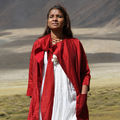Interviews
Sun protection with textiles, keeping cool head on hot days
20 Aug '10
6 min read
How is the UV protection factor of textiles indicated?
The protection from UV radiation that textiles provide is indicated as a UV protection factor (UPF = Ultraviolet Protection Factor). This equates to the sun protection factor (SPF) for sun creams and indicates the factor by which the skin's own natural protection time – which depends on your individual skin type - is extended by the textile material.
The skin of a person with skin type 1, for example, with red or blond hair, blue eyes and a very pale complexion, has a natural protection time of about five to ten minutes. If such a person is exposed to strong sunlight for any longer without protection, they risk dangerous sunburn.
If they are protected by a textile material with UPF 80, they can extend the length of time they can remain in the sun by eighty times, without causing any skin damage. That is to say, to a maximum of 6.5 to 13 hours (80 X 5 min = 400 min to 80 X 10 min = 800 min). However, care must be taken to ensure that all parts of the body not covered by textiles are given additional protection with sun cream.
Instead of the UPF, the manufacturers of UV protection textiles often quote what percentage of the UV radiation is blocked by their products. How can consumers evaluate this information?
Such statements are hard for lay people to interpret. If, for example, 95% of the UV rays are blocked, that equates to a UPF of 20. So if you really want to be on the safe side when buying shading textiles, you should always ask detailed questions, have the information carefully explained to you and compare that with your personal requirements, which depend partly on your personal skin type and the resulting natural protection time (see chart).
You recommend that for both shading textiles and clothing the UPF is measured in accordance with UV Standard 801. Why is that?
The UV Standard 801 was developed in 1998 to overcome the weaknesses in the previous test standard called the Australian/New Zealand Standard (AS/NZ 4399:1996). This did not take account of the stresses and strains imposed during washing and regular use. By contrast, under the UV Standard 801, the UPF of a textile is determined not only when it is new, but also when it has been stretched and wetted, after mechanical strain and washing and after artificial weathering.
How many companies have their products tested using this test method?
There are now over 100 companies making a variety of products offering high UV protection who have them tested and/or certificated under UV Standard 801. On the UV Standard 801 website, you can see a selection of companies which endorse their products using UV Standard 801.
What kind of products are mainly assessed under UV Standard 801?
We recommend the measuring procedure under UV Standard 801 because it produces highly practical results for shading textiles like sunshades, blinds and beach shelters and all kinds of clothing textiles. The range of products extends from swimwear and leisure and trekking clothes to the fabrics used for working clothes. The main focus is on swimwear and leisure clothing for toddlers and children, for whom protection from UV radiation is particularly important.
The protection from UV radiation that textiles provide is indicated as a UV protection factor (UPF = Ultraviolet Protection Factor). This equates to the sun protection factor (SPF) for sun creams and indicates the factor by which the skin's own natural protection time – which depends on your individual skin type - is extended by the textile material.
The skin of a person with skin type 1, for example, with red or blond hair, blue eyes and a very pale complexion, has a natural protection time of about five to ten minutes. If such a person is exposed to strong sunlight for any longer without protection, they risk dangerous sunburn.
If they are protected by a textile material with UPF 80, they can extend the length of time they can remain in the sun by eighty times, without causing any skin damage. That is to say, to a maximum of 6.5 to 13 hours (80 X 5 min = 400 min to 80 X 10 min = 800 min). However, care must be taken to ensure that all parts of the body not covered by textiles are given additional protection with sun cream.
Instead of the UPF, the manufacturers of UV protection textiles often quote what percentage of the UV radiation is blocked by their products. How can consumers evaluate this information?
Such statements are hard for lay people to interpret. If, for example, 95% of the UV rays are blocked, that equates to a UPF of 20. So if you really want to be on the safe side when buying shading textiles, you should always ask detailed questions, have the information carefully explained to you and compare that with your personal requirements, which depend partly on your personal skin type and the resulting natural protection time (see chart).
You recommend that for both shading textiles and clothing the UPF is measured in accordance with UV Standard 801. Why is that?
The UV Standard 801 was developed in 1998 to overcome the weaknesses in the previous test standard called the Australian/New Zealand Standard (AS/NZ 4399:1996). This did not take account of the stresses and strains imposed during washing and regular use. By contrast, under the UV Standard 801, the UPF of a textile is determined not only when it is new, but also when it has been stretched and wetted, after mechanical strain and washing and after artificial weathering.
How many companies have their products tested using this test method?
There are now over 100 companies making a variety of products offering high UV protection who have them tested and/or certificated under UV Standard 801. On the UV Standard 801 website, you can see a selection of companies which endorse their products using UV Standard 801.
What kind of products are mainly assessed under UV Standard 801?
We recommend the measuring procedure under UV Standard 801 because it produces highly practical results for shading textiles like sunshades, blinds and beach shelters and all kinds of clothing textiles. The range of products extends from swimwear and leisure and trekking clothes to the fabrics used for working clothes. The main focus is on swimwear and leisure clothing for toddlers and children, for whom protection from UV radiation is particularly important.
Hohenstein Institute
Popular News
Leave your Comments
Editor’s Pick
































-Ltd..jpg?tr=w-120,h-60,c-at_max,cm-pad_resize,bg-ffffff)





.jpg?tr=w-120,h-60,c-at_max,cm-pad_resize,bg-ffffff)
.jpg?tr=w-120,h-60,c-at_max,cm-pad_resize,bg-ffffff)






